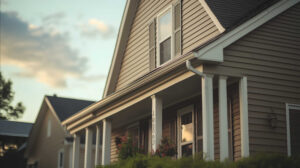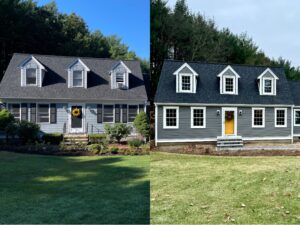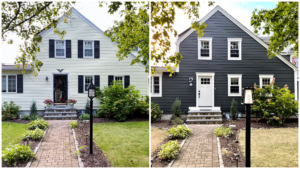

Project Manager at Plum ProExteriors
How Old Is My Roof? 10 Simple Ways to Determine the Age of Your Roof

A fundamental part of any residence is its protective canopy, the roof. As time passes, the roof endures the relentless assault of nature’s elements: the sun’s rays, raindrops, hailstorms, icy sleet, scorching heat waves, chilling cold spells, and debris. The longevity of a roof hinges on numerous variables, yet understanding its age and assessing its current state is paramount.
Knowing your roof’s age can provide a sense of security and peace of mind, as you’re aware of its condition and can plan for any necessary maintenance or repairs.
If you’re among the many homeowners asking, “How old is my roof?” check our guide prepared by experts at Plum ProExteriors. Here, we will consider the main ways to understand how old your roof is, including checking the building permit, discovering signs of aging, and consulting with a local roofing contractor.
So, let’s begin our research!
The importance of knowing the age of your roof
Why is it essential to understand the age of the roof? Discovering the age of your roof holds significant importance for various reasons, all contributing to your residence’s overall maintenance. Let’s consider the main reasons why it is vital to find the answer to the question how to tell how old a roof is.

Timely repairs
Being aware of your roof’s age allows for accurate anticipation of its maintenance requirements. Different roofing materials boast varying lifespans, and as your roof matures, it becomes increasingly vulnerable to damage from environmental elements. Armed with knowledge about its age, you can proactively schedule regular inspections and upkeep to promptly address any issues, thus prolonging its durability and avoiding costly repairs or untimely replacement.
Property transactions
Furthermore, the age of roof bears considerable weight in property transactions. Whether you’re buying or selling a home, having precise information about the roof’s age can significantly influence negotiations. For sellers, transparent disclosure about the roof’s age and condition fosters trust with potential buyers and mitigates future disagreements. For buyers, understanding the roof’s age facilitates better financial planning, ensuring readiness for any forthcoming maintenance or replacement expenses.
Home insurance
Additionally, your roof’s age may impact your home insurance premiums. Insurance providers often factor in the age and condition of the roof when determining coverage and pricing. A newer roof with an extended expected lifespan may qualify for reduced premiums, whereas an older roof nearing its useful life’s end may incur higher insurance costs or necessitate supplementary coverage for replacement value. We will consider how to determine age of roof for insurance later in this brief.
Overall, knowing the age of your roof, you can make informed decisions regarding its care, upkeep, and potential replacement. It is a proactive measure to safeguard your investment in your dwelling, elevate its worth, and ensure the safety and comfort of your household for years ahead.
Factors that define the functional age of roof
Numerous factors influence a roof’s functional age. It’s crucial to consider these when considering a roof replacement or evaluating a potential home purchase. These factors can even accelerate the deterioration of new roofs beyond expectations.
Craftsmanship
The quality of workmanship during roof installation can profoundly influence its longevity. Improperly aligned shingles, gaps, and incorrectly installed underlayment can lead to leaks and moisture accumulation, hastening the roof’s wear and tear over time.
Underlayment
The right underlayment provides a secondary defense against elemental damage as a waterproofing layer beneath shingles and sheathing. However, incorrectly installed or damaged underlayment can trap moisture, which leads to mold growth and compromises indoor air quality.
Regional climate
Certain geographical areas, such as the Midwest and coastal regions, experience weather patterns that can adversely affect roofs, shortening their expected lifespan.
Roof and attic ventilation
Inadequate roof and attic ventilation can result in excessively hot roof temperatures. This heat buildup accelerates shingle deterioration and contributes to issues like ice dams, swelling, moisture buildup, and rot.
Roof material
The primary determinant of a roof’s lifespan is its material. Generally, higher-quality materials correspond to longer roof lifespans, albeit with higher installation costs. Here’s a brief overview of some commonly used roofing materials:

- Asphalt and shingle roofs: Asphalt shingles, widely utilized for their ease of installation and affordability, typically last 15-20 years under ideal conditions.
- Wood shingles: More resilient to wind and durable than asphalt, wood shingles require regular maintenance, including fungicidal treatments every three years, to prevent issues like termite infestation, mold growth, and warping. With proper upkeep, wood shingles can last up to 30 years.
- Metal roofs: These roofs are increasing in popularity due to their sustainability and aesthetic appeal. They offer longevity and low maintenance requirements, and depending on quality, they can last 25-70 years or more.
- Clay tile shingles: Known for their durability and resistance to the elements, clay tile or concrete tile shingles can last over 50-100 years, albeit with higher upfront costs and construction requirements.
- Slate shingles: The epitome of roofing durability, slate tiles can endure for 50-200 years, making them a premium but long-lasting option that requires specialist installation due to their weight and complexity.
Now, let’s consider the main ways to discover the answer to the question how to tell how old a roof is. Some of them are simpler to use, and some require a little more effort, but they all will be helpful.
10 best ways to understand how old is the roof
We know that determining the age of your roof can be challenging, particularly if you’re not the original homeowner or haven’t enough roofing expertise. However, once you establish the age of your roof, you gain valuable insights into its overall safety and resilience against harsh weather conditions.
The experts from Plum ProExteriors have compiled the top ten methods to help you find the answer to the question, “How old is my roof?”. Apply them to make an accurate assessment.
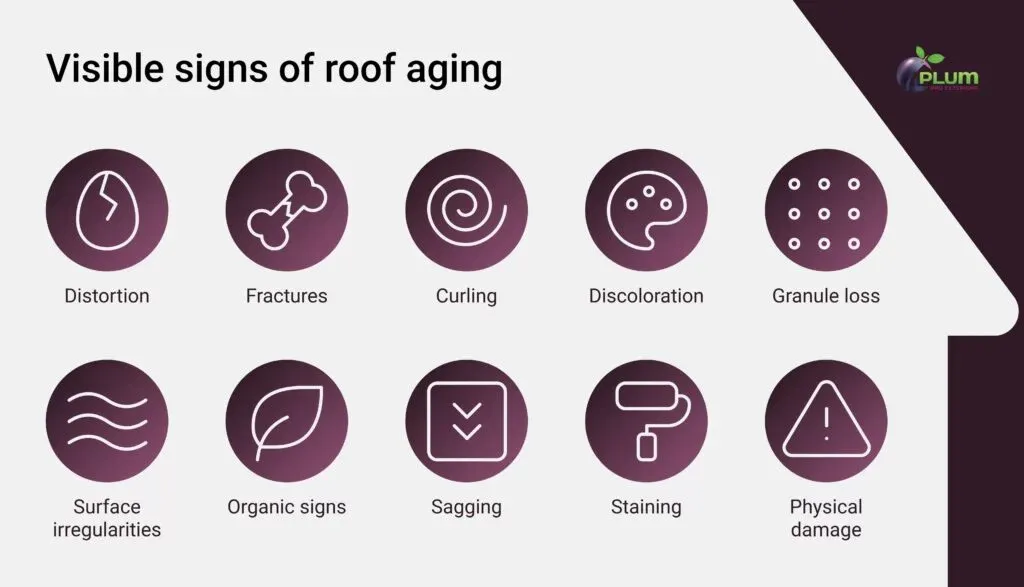
Check the building permit
Upon purchasing a home, a plethora of documentation accompanies the transaction, ranging from the deed and tax records to closing disclosures and various affidavits. Ideally, this paperwork includes the building permit, a crucial piece of information to scrutinize.
Reviewing your records can reveal whether the permit is included, offering insight into significant work conducted on the property.
Additionally, it’s prudent to inquire with your county for building permit records pertaining to your home, particularly concerning roofing projects. Pulling permits is a prerequisite for homeowners or contractors before commencing such work. These records not only specify the permit issuance date but may also encompass inspection documentation upon project completion, a standard requirement in most counties.
Building permit records furnish a comprehensive timeline of actions taken, shedding light on the quality of roofing or repairs undertaken. This invaluable information equips roofing contractors with the details necessary to address your roofing needs accurately. Moreover, it enables them to offer tailored advice on future maintenance steps to safeguard your roof and home effectively.
Examine roofing warranty documents
Seeking warranty documentation concerning your roofing materials or workmanship is another crucial step. Typically, these documents include the installation date, providing valuable insights into the roof’s age. Reputable roofing material manufacturers often offer warranties, as do responsible roofing contractors, which can further elucidate the roof’s age.
In instances where such documentation is unavailable, an alternative avenue exists. Investigate information directly from the shingles themselves, including their model and type. Sharing this data with the manufacturer can yield details about the shingles’ production years, aiding in determining their age and potential installation date.Once armed with the approximate roof age estimate, informing your roofing contractor enables them to conduct a thorough inspection. This assessment allows them to discern whether the roof exhibits typical or atypical wear for its age, guiding subsequent maintenance or replacement decisions.
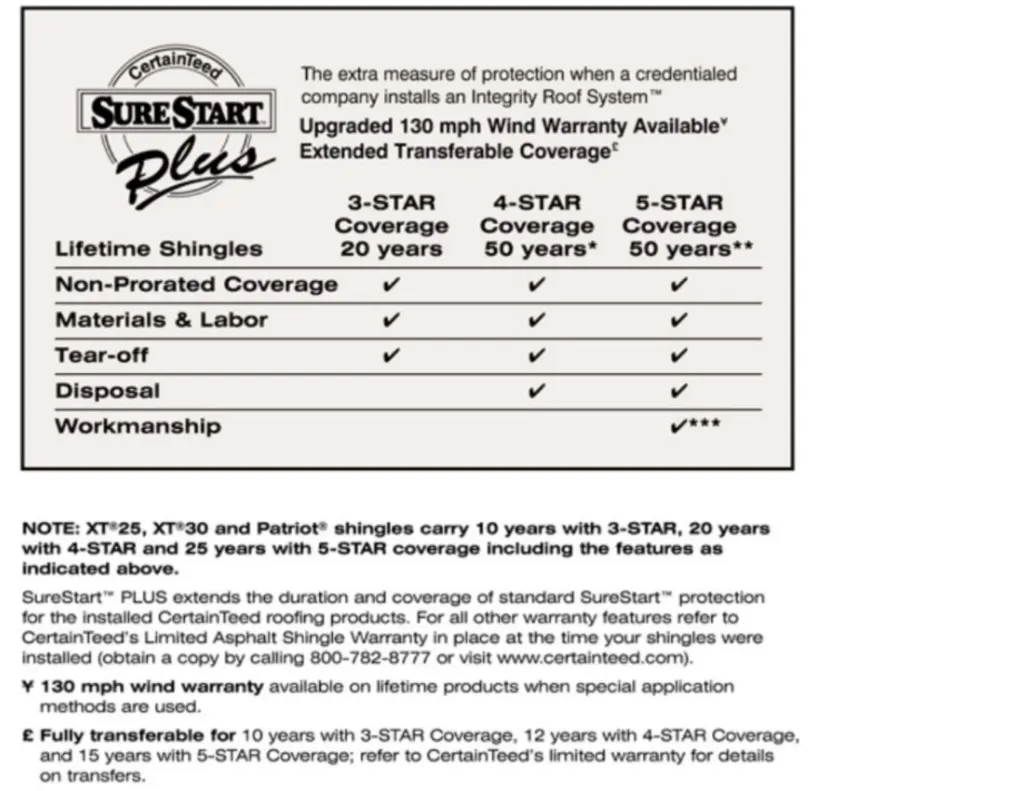
Ask the previous owners
Certain homeowners encounter significant challenges when there’s a lack of documented evidence tracing the history of home renovations. In such instances, recourse involves reaching out to individuals connected to the house’s past.
One valuable resource is the previous owner, particularly if they resided in the home for an extended period. If you possess their contact details, initiating a conversation to inquire about the roof and any past replacements can yield valuable insights. Most individuals are receptive to such inquiries and may even enjoy reminiscing about their former residence, given the memories associated with it.
However, if the previous owner’s contact information is elusive, attempting to contact them may be difficult. Then, turn to the real estate agency involved in the property sale. Their records typically contain the needed information.
In an ideal scenario, engaging with the previous owner or real estate agent yields ample information to inform your decision-making process.
Seek aerial photographs or satellite imagery
Surely, it is not a routine practice. But there are instances where delving into aerial photography about your residence can prove beneficial. Satellite imagery spanning several years to decades can provide valuable insights into the history of your roof. Any color changes in the roof between successive sets of photos indicate a potential need for replacement.
Although satellite imagery is a reliable source, exploring additional sources is advisable. This includes researching local archives and online databases and contacting government agencies regarding their visual archives. Moreover, consulting with local historical societies can assist you in receiving records about aerial imagery that will help you better understand your roof’s evolution over time.

Analyze your neighbors’ roofs
It’s uncommon to find homes in a neighborhood constructed decades apart. Instead, residences within the same community are typically built concurrently, resulting in similar architectural styles and roof ages. Even if there are variations in shingle color, they generally indicate roofs of comparable ages.
Have you observed an increase in roofing companies operating within your neighborhood? This trend may be attributed to homes being constructed around the same period. Given the finite lifespan of asphalt roofing products, it’s understandable that many roofs are experiencing varying degrees of deterioration, necessitating repairs or replacements.
Exceptions to this pattern may arise due to specific incidents, such as severe storms causing extensive damage to individual roofs, resulting in replacements. Additionally, occurrences like house fires or falling tree limbs can lead to newer roofs in the vicinity.
In scenarios where 3-tab shingles were utilized by the home construction company, these shingles typically endure approximately 15 years under normal conditions. Alternatively, if thicker and more durable architectural style shingles were chosen, they typically last around 25 years.
A closer examination of your neighbors’ roofs offers valuable insights. Comparing their roofs to yours and discussing observations, such as the presence of granules in downspouts, can provide indications of roof aging. These granules, which serve as protective outer layers on shingles, diminish over time, serving as markers of an aging roof.
Search for the previous roof replacement company
Roofing companies maintain meticulous records, providing a valuable resource for obtaining information about your roof’s age. In cases where previous owners and real estate agents are unable to recall the date of any re-roofing but remember the contractor’s name, reaching out directly to the contractor can yield essential details. Given that many roofing contractors offer workmanship warranties, they possess precise records of when the work was conducted.
If determining which roofing contractor performed the re-roofing proves challenging, there is an alternative approach. It involves compiling a list of local contractors and contacting them individually to inquire about their involvement.
Find the manufacturer’s information on shingles
You can try a more investigative approach to find the answer to the question, “How to tell how old a roof is?”. Exploring the manufacturer of the shingles themselves could reveal valuable insights into your roof’s age. However, it’s worth noting that the manufacturer’s information is typically found on the underside of the shingles. So, you should be careful when lifting a shingle section without causing damage to surrounding areas. It is better to turn to a professional team like Plum ProExteriors to do this.
The details provided on the back of shingles may vary among manufacturers. It’s uncommon for them to imprint the production date or a manufacturing code on each shingle, necessitating inspection of multiple areas. Additionally, the information on the shingle may pertain more to the manufacturing process rather than providing specific dates. Moreover, a single code on the shingle may be utilized over several years, potentially leading to a less precise estimation of the shingles’ age.
Engaging with the manufacturer’s customer service can be beneficial, as they can help you decipher the codes imprinted on your shingles.
Discover visible signs of roof aging
As roofs age, they gradually exhibit distinct indications of deterioration. These signs include warping, cracking, and color changes. Inspecting all roof sections carefully for any signs of wear is essential. Are there variations in the texture of the outer granule layer? Do you detect any areas of balding or irregular surface contours? Below, we have mentioned the main signs of roof aging. They will help answer the question how to find age of roof.
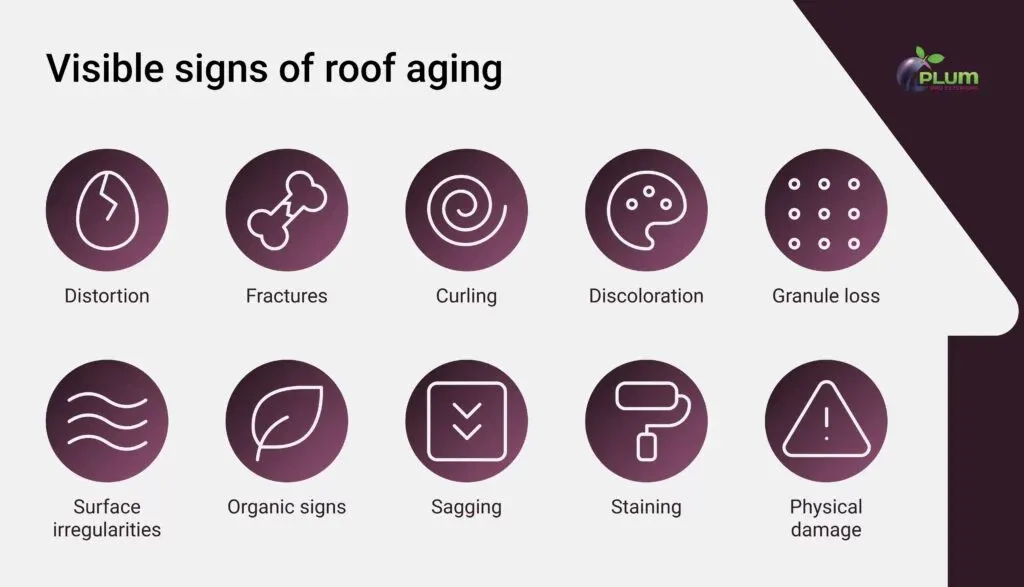
- Distortion: Irregular or uneven areas on the roof’s surface.
- Fractures: Cracks appearing in the shingles or roofing material.
- Curling: Shingle edges curling upwards or downwards.
- Discoloration: Observable changes in the coloration of the roof material.
- Granule loss: Gradual erosion of granules from the shingles, resulting in a smoother texture.
- Surface irregularities: Unevenness or waves across the roof’s surface.
- Organic signs: Development of moss, mildew, algae, or dark streaks on the roof.
- Sagging: Noticeable drooping or sinking sections of the roof structure.
- Staining: Water stains or dark marks visible on the attic or upper floor ceilings.
- Physical damage: Signs of wear such as punctures, tears, or missing shingles.
Inspect the attic and chimney for potential clues
Even if everything appears intact externally, there might be indications within your home, or around key roof features like the chimney, that your roof’s protective capabilities have diminished over time.
The attic is the main location where such issues can be investigated. You can equip yourself with a flashlight and venture into your attic, whether a spacious area or a confined crawlspace, to search for telltale signs of roof deterioration, often manifested as moisture-related damage.
Signs of roof problems within your attic may range from sagging sections to dark streaks, stains, and evidence of ongoing moisture infiltration. In many cases, moisture issues in the attic can seep into interior walls, remaining unnoticed until significant damage occurs, necessitating costly repairs.
Alternatively, clues left behind by previous roof work, such as unused shingles with original packaging and documentation, can provide insights into the age of your roof.
Consult with a local roofing contractor
If you have tried many approaches to determining the age of your roof without success, what should you do next? The logical step in this case is to enlist the expertise of a seasoned professional—someone with extensive experience and a keen eye for detail.
It’s crucial to understand that while a local roofing contractor possesses various tools to evaluate a roof’s condition, there’s no assurance that they can precisely determine its installation date. Instead, they can provide an estimate based on their expertise. However, they can thoroughly examine specific areas requiring attention and offer recommendations regarding the overall condition and maintenance of the roofing system.
Try these methods if you are searching for information on how to determine age of roof. One of them should definitely suit you. Use this knowledge to keep your home in top condition.
Get top roofing services from Plum ProExteriors
For top-notch roofing services, turn to Plum ProExteriors, your #1 roofing contractor in Southborough, MA. We also serve a 30-mile radius around our office. Our professional team is here to cater to all your roofing needs. We can help you with the installation and replacement of your roof to improve your home’s look and condition. Also, we are always ready to assist you with inspecting your roof state. Here are our main roofing services:
- Residential roofing: Plum ProExteriors specializes in residential roofing installations, from traditional two-story homes to cozy bungalows. With over a decade of experience, our team ensures efficient and safe removal and installation, prioritizing professionalism in every project.
- New construction: By seamlessly integrating our roofing services into new construction projects, we ensure timely completion without disrupting other on-site activities.
- Modern installations: Looking to install a new roof? Plum has you covered. With years of expertise, we guarantee swift and efficient new installations, completing the job in just a few days.
You can be confident in the reliability of the materials we use. We exclusively apply top roofing brands renowned for their quality and reliability. From GAF’s award-winning innovation to CertainTeed’s versatile options, our team ensures precise installation every time.

You can also choose from a variety of roofing types to suit your preferences and needs:
- Metal roofing: Constructed from metal sheets, these roofs boast exceptional durability and longevity. With fire-resistant properties and heat-reflective capabilities, they contribute to reduced cooling expenses.
- Cedar shake roofing: Embracing a timeless appeal, cedar shake roofs offer homeowners a stunning, natural aesthetic. This popular choice adds charm and character to any property.
- Slate roofing: Considered a luxurious option, slate roofs are renowned for their durability and elegance, often lasting for centuries. While they come with a higher price tag, their unparalleled beauty makes them a sought-after choice.
- Asphalt shingle roofing: Widely prevalent across North America, asphalt shingle roofs are prized for their affordability and ease of installation. This common roofing type provides a cost-effective solution without compromising on quality.
- EPDM roofing: Ethylene propylene diene terpolymer, commonly known as EPDM, serves as a versatile flat roof membrane. Recognized for its cost-effectiveness, superior water resistance, and impressive lifespan, EPDM roofs offer long-term reliability.
Hire our skilled team if you want to replace or refine your old roof and enjoy superior services tailored to your needs. We can also help you find information on how to determine age of roof.
Conclusion
Unearthing the age of your roof might seem like detective work, but with the methods explored above, you’re well-equipped to crack the case. Building permits, warranty documents, and conversations with neighbors can offer valuable clues. However, consider turning to a professional roof inspection by reliable local contractors for the most accurate assessment.
Rather than leaving things to chance, proactive measures today can prevent many headaches tomorrow. Contact Plum ProExteriors to schedule a roof inspection, and we will provide you with a roof age estimate to help safeguard your home’s future.
